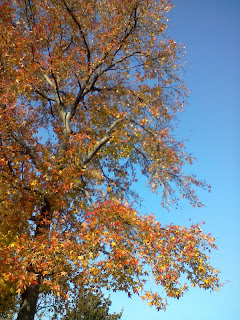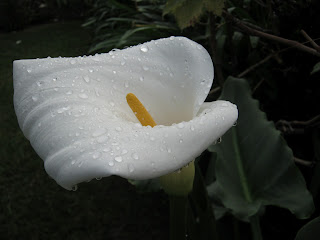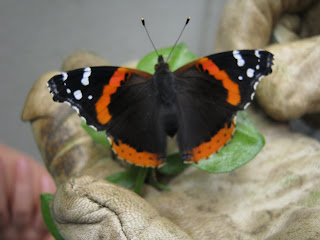Gardening in north Orange County, California
Monday, December 19, 2011
Thursday, December 15, 2011
Tuesday, December 13, 2011
Wednesday, November 2, 2011
Friday, October 14, 2011
Sunday, October 2, 2011
Friday, September 30, 2011
Thursday, September 22, 2011
Monday, September 5, 2011
Sunday, August 21, 2011
Tuesday, August 16, 2011
Tuesday, August 2, 2011
Wednesday, July 27, 2011
Green lynx spider
We found this spider on the fading blooms of some peacock orchids (Acidanthera) this afternoon. It is a green lynx spider, Peucetia viridans, probably a male as they tend to be more slender than females. The green lynx, named for its cat-like habit of pouncing on its prey, is a common garden spider in southern California, ranging from coast to coast in the southern United States as well as Mexico and Central America.
According to the Galveston County Master Gardeners, the green lynx spider is known to prey on beneficial insets such as butterflies, honeybees, pollinating flies, wasps, and other nectaring insects, but is of interest in agricultural pest management as an important predator of crop-damaging insects such as harmful caterpillars.
Tuesday, June 28, 2011
Wednesday, June 1, 2011
Saturday, May 28, 2011
Red admiral
I found this butterfly when I was weeding this morning. It was very sluggish, and had its antennae folded back under its wings for a long time -- perhaps it was newly come from its chrysalis? It kept its wings closed for some minutes, even as I picked off the sprig it was resting on, and carried up to the house, admiring the beautiful mottled black and brown and tan of the underside of its wings, like the cross-section of a sedimentary rock -- then it suddenly dropped its wings open to reveal the orange stripes.
This is a red admiral (Vanessa atalanta). I regret to say that our back yard has quite a lot of stinging nettles -- or had, before this morning -- although apparently the upside is that the red admiral caterpillar is quite fond of them.
(The pictures are a bit blurry ...)
Monday, May 9, 2011
Rosa "Cécile Brünner"
"Cécile Brünner" -- also called the "Sweetheart Rose", "Climbing Mignon", or "Buttonhole Rose" -- is a polyantha first introduced in 1881, and in its climbing form in 1894. It has long been a favorite of gardeners, for its pretty pale-pink flowers and its hardiness in a wide variety of climates and conditions, as well as resistance to most rose diseases. It can grow from 15 to 30 ft. (4.7 to 9 m), but is easily kept smaller.
This particular bush was whacked back to stubs a few months ago, but has bounced back quite prettily.
Sunday, May 8, 2011
Wednesday, April 27, 2011
Monday, April 25, 2011
Rosa "Iceberg"
"Iceberg" is one of the most popular roses in the world. Its simple beauty and easy growing habits make it an excellent choice for gardens, whether for cutting or just enjoying. It "plays well with others" -- especially lovely, I think, with lavender at its feet -- or looks stunning in a mass.
"Iceberg" is a floribunda rose -- Latin for "many-flowering" -- which were developed in the early 1900s as a cross between hybrid teas and polyanthas, in order to take advantage of both the polyantha profusion of blooms and the hybrid teas' looks and color range. Typical of the floribundas is the mass of blooms on a single cane. "Iceberg" was introduced in Germany in 1958; there it is known as "Schneewittchen" -- "Snow White". It also comes in a climbing form.
Monday, April 18, 2011
Rosa "Gertrude Jekyll"
The roses around Fullerton certainly enjoyed the rainy winter we've had, and are blooming beautifully. This one is "Gertrude Jekyll", an Austin English rose named after the famous gardener. (It is pronounced "JEE-k'll".)
This rose has a beautiful old-rose shape, a vivid clear-pink color when the blooms are new, usually fading and softening a bit, and an utterly breath-taking scent. I have had few problems with it, other than keeping its robustness under control -- there's a reason its nickname is "Galloping Gertie"!
It has a slight repeat in the autumn, here in Fullerton.
I have this growing on a trellis attached to the side of the house along our narrow driveway, growing to one side of the trellis so that the canes can be laid along the length of the horizontal bars, on the same principle as self-pegging, thus increasing the bloom. This is not perhaps the best spot for a rosebush, as we can't get in and out of the car next to it for the exuberant thorns, but it seems very happy in this usually-difficult spot.
Monday, April 11, 2011
Alyssum and lobelia
This combination of white alyssum and blue lobelia is growing very prettily in a dappled-shade area under a decorative bench at the edge of a path.
Sunday, April 10, 2011
Saturday, April 9, 2011
Wildflower garden
A very charming front garden in the Preservation District of Fullerton. Included are California poppies (Eschscholzia californica) and mountain garland (Clarkia unguiculata), both California natives. Mountain garland -- the tall pink ones here -- are also known as elegant clarkia.
Friday, April 8, 2011
Wednesday, April 6, 2011
Tuesday, March 22, 2011
Thursday, March 3, 2011
Pink jasmine
Pink jasmine, Jasminum polyanthum, is an evergreen vine with dense clusters of star-shaped flowers, white on the inside and rose-pink on the outside, from beautiful rose-pink buds held upright, from February to July in Sunset zones 22-24 (a little later in colder areas). The scent is heavenly, rather perfumy and exotic.
The vine can grow up to 20 ft. (6 m), in sun or partial shade. This particular vine is growing in a rather unforgiving western exposure, with no regular water. Sunset notes that J. polyanthum can be grown as a climber, a ground cover, or in containers -- here in Southern California it is usually to be seen climbing on fences or trellises, but would make an interesting ground cover, although in Australia and New Zealand at least, it is regarded as invasive, as it roots easily from stem material.
Wednesday, February 23, 2011
Daffodils
Sunset calls the daffodil -- properly Narcissus -- the "most valuable spring-flowering bulb for most regions of the West". They are permanent (unlike, say, many tulips, which must be replanted every year in this temperate climate), they increase from year to year, are hardy in cold and heat, tolerate sunny to partly-shady situations and a variety of locations, they naturalize beautifully, and need little water with average autumn rains. They also grow well in containers.
Daffodils bloom in late winter and early spring.
Daffodils come in eleven recognized forms, depending on trumpet shape and size, segments (petals), number of blooms per stem, and so on. Colors are usually yellow and/or white, but newer varieties come in variations of red, orange, pink, and cream. The blooms pictured are trumpet daffodils, where the trumpet is as long or longer than the surrounding flower segments -- they are possibly the classic variety "Dutch Master" or "King Alfred".
Daffodils are tempting to slugs and snails, especially during the flowering season, but are resistant to gophers and deer.
Apparently daffodils usually face the sun. These particular blooms seem a little confused, but still are growing quite happily in a dappled-sun parking strip in the Golden Hills area.
Subscribe to:
Posts (Atom)

















































